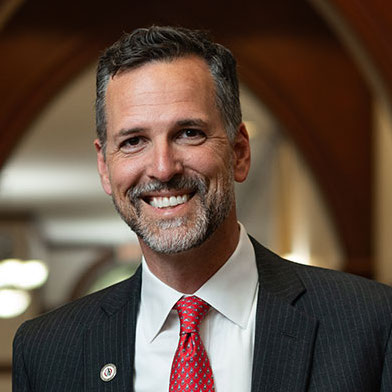“The Coalition for the Common Good is all about collaboration,” says Dr. John Comerford. “We want partners who want to build something together. It’s all based around a mission of social justice and democracy and making this world a better place.”
The Coalition, which was founded in late 2023, is the first national higher education system of affiliated universities organized around a shared mission of educating students not only to advance their careers, but to promote our pluralistic democracy; social, racial, economic and environmental justice; and the common good. This partnership, between individual colleges and universities, allows each institution to pool resources, reach more people and expand its academic programs, as well as its national footprint. Above all, it amplifies the opportunities they can provide their students — who will, in turn, go on to become champions of change for good in our society.
Comerford, who serves as president of the Coalition for the Common Good, is also president of one of its two founding members, Otterbein University, a private, comprehensive, liberal arts university located in Westerville, Ohio, with an enrollment of about 2,500. The other founding member of the Coalition is Antioch University, a private university with multiple campuses throughout the U.S. and a wide range of traditional campus-based, low-residency and online programs.
“I lead, along with a number of other folks, our efforts to build a new systematic approach of collaboration between independent institutions of higher education, starting with Otterbein and Antioch, where we keep the independence of the liberal arts curricula at places like Otterbein but leverage together into the adult market through Antioch,” Comerford says.
One of his fellow leaders in this endeavor is Michelle Koppitz, associate vice chancellor of strategic initiatives and partnerships for Antioch and the Coalition, who focuses on forging connections with external partners to help carry out the Coalition’s mission.
“That mission is providing more achievable access to higher education, but to do so while taking into consideration the strategic goals of both individual students as well as organizations that can help support that journey,” Koppitz says. “Those organizations include, of course, corporations, but also healthcare networks, municipalities, associations. It’s my role to be the conduit between our institutions and the various departments within our institutions that can support creating pathways from workforce development all the way to doctoral programs, in some cases, and certainly for organizations to achieve their strategic workforce development and learning goals.”
It’s an innovative new model that allows universities to move from being competitors to collaborators to better serve students and communities while preserving their own institutional identities and cultures. And it’s one that will be better positioned to address the needs of industry in the U.S., providing accessible and affordable workplace education, Comerford says.
Three initial goals
The Coalition for the Common Good was formed with three primary goals in mind, the first being: Expand access to adult education.

“Antioch is our adult education provider — mostly graduate programs, but also bachelor’s degree completion programs, and we’re growing into corporate professional development work,” Comerford says. “For schools like Otterbein, we need to be in the adult market because that’s where the growth is; there’s not enough 18-year-olds to go around. It’s a shrinking population and marketplace.”
However, as Comerford explains, a place like Otterbein isn’t well set up for adults, as it functions like a traditional university, with classes taught during the day, in person, and its technology and faculty are set up to support that model.
“We’re taking Otterbein’s graduate programs and making them Antioch programs so that we can use Antioch’s network of five campuses to do adult education at a larger scale,” Comerford says.
A second initial goal for the Coalition was the establishment of a shared services division among its members that handles non-student-facing functions, such as accounting, HR and IT, for example, that can be done together, at scale, to save money and provide a better staff experience for Coalition members.
“And last but not least, it’s a way for Otterbein to differentiate itself,” Comerford says. “All colleges sort of look the same sometimes. By being a part of the Coalition, our students, our undergraduates, have early access to graduate programs, and you can overlap your senior year and get your master’s, your doctorate, faster, and get in the workforce faster and save some money. So, that’s a marked differentiator for a place like Otterbein.”
As the Coalition grows, these efforts are intended to scale, not just in the number of adult learners, but through the addition of independent institutions and business partners. And in the short amount of time since the Coalition’s inception, it has made impressive strides.
Programs, partnerships & growth
Today, unified under its mission, the Coalition operates out of six campus locations nationwide, including Antioch’s campuses in Keene, New Hampshire; Los Angeles and Santa Barbara; Seattle; and Yellow Springs, Ohio, as well as Otterbein’s campus in Westerville. Distance and extended education are also provided through Antioch University’s online graduate and undergraduate programs.
In total, these offerings comprise more than 95 undergraduate programs and concentrations, 50 graduate programs and concentrations, 10 doctoral programs, 45 certificate programs, more than 100 continuing education courses and 35-plus online/low-residency programs and concentrations. The programs allow for seamless transitions from undergraduate to graduate degrees, across member institutions, such as early admission pathways.
The Coalition also now has 38 Coalition Partnerships, within a number of sectors, including healthcare, education, military and military-connected, social services and academic alliances.
All partners receive access to Otterbein and Antioch degree programs specific to their sector and workforce and professional development opportunities onsite or online, built specifically around their mission and culture.

“We’re looking at creating programmatic portfolios for organizations that meet their strategic goals,” Koppitz says. “But in order for the organization or the individuals to achieve those goals, we have to meet the students where they are. And some of those employees may be at a place where they simply need a professional development achievement. Others may be at a place where they started a degree but didn’t finish it. And yet others may be at a place where they have their bachelor’s degree but are looking at different levels of bringing their learning to others within the organization through a management or leadership position.”
Comerford adds: “We want to do it as a recruitment and retention incentive for their employees. And the power that we bring is not just expertise in the field, but as an accredited institution, we can bring academic credit.”
As the Coalition continues to scale, it is looking for partners who are mission-aligned — who want to contribute to their practical realities, grow and be successful — but also who have a vested interest in the growth of those who work for them and in positively impacting society.
“At the end of the day, we want to be able to help organizations and individuals achieve their goals, but ultimately to have an impact on economic and social justice,” Koppitz says. “Doing so in collaboration with these organizations is critical to achieving that.”
The path forward is collaborative
The Coalition is young, and Comerford is proud of what has already been accomplished and what these early markers indicate for the future.
“The idea was always to bring Antioch programs to central Ohio, and to take Otterbein programs to Seattle and L.A. and Santa Barbara and New England, where Antioch is operated,” he says, “and so the fact that we now have programs like a Master’s in Clinical Mental Health Counseling and a Doctorate of Education in central Ohio, and that we’ve hired a dean for nursing and health professions at Antioch who’s working to bring nursing and allied health and athletic training to Seattle and then L.A. — the academic programs getting to be real have felt like important milestones.”
The Coalition has also started to receive data from some of its early partnerships, Comerford says, and it’s promising: Employee retention and productivity are both trending upward. These early indicators, coupled with growth in partnerships and enrollment, will be key areas to watch as the Coalition moves forward.
“We imagine a dozen or more schools eventually in the Coalition for the Common Good,” Comerford says. “And that will happen slowly; getting a school onboard is complex. I’d also be watching for the number of adult learners we serve. When we formed the Coalition, Antioch had about 4,000 students. That should be in the next few years, 5,000 or 6,000 students, and eventually 10,000 students, 100,000 students or more. There are lots of adults who need to be served, and if we’re getting to them and serving them and growing, that’s a really good sign that this is working.”
One of the biggest indicators of success, he says, will be the overall acceptance, adoption and strength of this new model.
“Higher education is a mess. And the more we’re looked to for leadership as a new model, in terms of financial structure that works, that’s sustainable, in terms of corporate connections that work and building a bridge to the workforce, in an industry that otherwise doesn’t do a good job in those areas — I’d be watching that.”
A key component of the Coalition’s journey forward and future success lies in collaboration, a point that is underscored by both Comerford and Koppitz.
“We recognize that higher education has not always been collaborative with business organizations,” Koppitz says. “We haven’t always been as adaptable as we could or should be. This shift for the Coalition is really about: If we were to understand what it means to truly be amenable to what the needs are of organizations, what does that look like?”
With this top of mind, the Coalition has shifted many of its processes and operations to a model that is needs-based. With partners, this can involve conducting a strategic needs assessment with an organization on workforce development over the course of three years, looking at what deliverables the Coalition can offer and customize in some cases, and delivering a full portfolio to meet those needs.
“We’ve adapted how we approach achieving goals of strategic academic programming by adapting to the way that some of these businesses and sectors function,” Koppitz says. “We can’t go into healthcare, for example, and not understand that they have shift work; they can’t go to a main campus three days a week for a traditional classroom setting. So we’ve adapted our delivery models, we’ve adapted our business models, and we’ve also adapted the way that we approach these stackable credentials to ensure that folks are able to apply what they learn immediately, but also have value in all of their learning.”
The Coalition team works to support its partners through both project management and employee outreach and student support services, Koppitz says. This means working collaboratively with partners to ensure they have a high-touch, high-engagement relationship with the Coalition, as do their employees, so they’re being supported in a way that ensures they are progressing toward educational achievement.
“The Coalition is all about collaboration,” Comerford stresses. “If you have workforce professional development or other sorts of needs, we’re here to have a conversation, and maybe we can meet that need. But we want to build something together.”
Interested in learning more about the Coalition? Listen to our Voices of CLO podcast featuring Dr. Comerford!
The Coalition for the Common Good is a corporate member of BetterWork Media Group, the parent company of Chief Learning Officer. Learn more about the Coalition by accessing BetterWork Media Group’s Corporate Member Directory.















